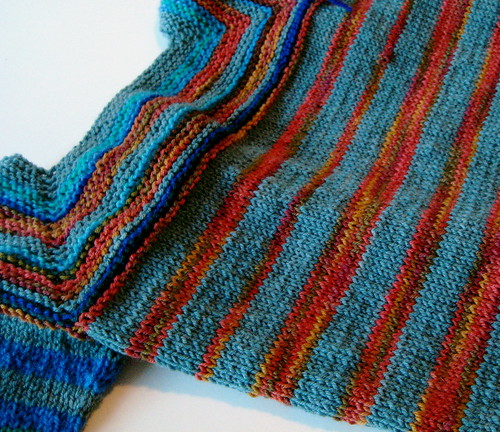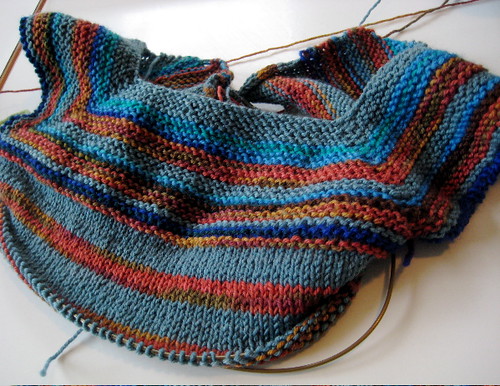
I decided it was time to make a help page for knitters who have questions about my free patterns. Of course, you can still
email me with your specific questions - and I'll be as timely as I can in responding. But chances are, you'll find what you need to know on this page. I hope that some of you find this help page useful! If there's anything else you'd like to see here, please let me know in the comments.
Table of contents
What does this abbreviation mean??
I use standard abbreviations in all my patterns, but this may be one you haven't run across before. Check the
Yarn Standards abbreviations guide, or the
Knitty abbreviations guide (scroll down).
How do you do a [insert name of technique here]?
My favorite resource for learning a new technique is
KnittingHelp.com. The video illustrations are wonderful - the next best thing to having a friend show you how to do it.
Also, if you've been knitting a little while and you know you're going to stick with it, I'd recommend investing in a big, handy book full of knitting techniques. These are easy to find used on the web and in bookstores. There are plenty to choose from, but two I have at my house are the
Big Book of Knitting by Katharina Buss, and the
Knitter's Handbook, by Montse Stanley. They really come in handy when you're adapting a pattern to your own liking, or when a designer is skimpy on the directions.
Sizing: How do I know which size will fit?
All my designs use standard sizing from the
American Craft Yarn Council (sounds very official, doesn't it?). Unless they state otherwise, most designers in the U.S. follow these guidelines, so you should find some consistency among different patterns. To see what the standards are based on, check out this
sizing guide.
Which size should I knit for my child who is __ months/years old?
The age-related sizes that I provide are a little bit misleading, since every kid is different and grows at a different rate. Your two year-old might be wearing a 4, while someone else's 4 year-old might swim in a size 3. The sizes are based on standard sizing from the
American Craft Yarn Council. The best way to know what size to knit for a baby or child is to measure his or her chest circumference. Add two inches for ease, and that chest size tells you which size sweater to knit. I usually provide the chest measurement in the pattern, but if I've overlooked it (sorry!), check the Craft Yarn Council's
sizing guide for babies & children. When in doubt, go up a size! In the mean time, I'm going to go make sure there are chest measurements on all my patterns...
Check out this
tutorial I wrote on adapting top-down patterns to fit other sizes.
What size should I knit for me? I am between the sizes you provided.
No body conforms to a standard size. If you happen to be a perfect size medium, count yourself lucky. No matter what the garment, you will most likely need to adapt a knitting pattern to fit you well. The American Craft Yarn Council's
sizing guide shows you how to measure yourself to determine your sizing. There are lots of instructions out there about how to adapt patterns to fit you - making the chest larger or smaller, adding darts, shortening or lengthening the sleeves or the sweater length. Check out the instructions in
Stitch & Bitch Nation by Debbie Stoller, or Jenna Wilson's wonderful column in Knitty,
Thinking Beyond the Pattern. As your knitting progresses, it's important to learn how to adapt patterns to fit well. Nothing's worse than spending months knitting a project that turns out looking like a muu-muu when you put it on.
A related question: Will this style of sweater look good on me?
This is a critically important question that is not so much about knitting, as it is about understanding your body shape and what will flatter it (and what will look awful). I always get depressed when I see someone's project on Ravelry, and they write about all the fun they had knitting a garment, only to find that the style didn't exactly flatter their figure. You can avoid this tragic and all-too-common problem by spending a little time with some fashionistas. The best in the business (I.M.H.O.) are Stacy and Clinton at
What Not to Wear. There are some helpful
tips on their website, but I adore their book,
Dress Your Best: The Complete Guide to Finding the Style that's Right for Your Body. Never knit another clunker!
Quickie Cowl FAQ
The directions for the Modified Lace Rib show only Row 1, Row 2 and Row 4. What the heck do I do on Row 3? How do I "repeat these 4 rows" when there are only three given??Check it out: Row 1 is more than it seems.
Row 1 and all WS rows: *K2, P3. Repeat from * to end. K2. "Row 1 and all WS rows" means that on every wrong-side row (in this case, all odd rows), you do the same thing. Row 3 is one of those WS rows.
Which set of directions do I follow? Do I dig right into the Lace directions or follow the second set, ie., First row: K3…. Or do I start with the directions after the CO and then follow the lace pattern? What am I overlooking?
I can't figure out the pattern either. Could you please write it out as Row 1, Row 2, etc. without the separate directions for "modified lace rib" and "knit the Cowl"?
I'm so sorry to torture you. This cowl is so simple, and I had to go and complicate the directions. Here's the quickie answer: You do both at the same time.
This is a standard convention in knitting directions when you're doing a fancy stitch pattern, particularly lace: the fancy stitch pattern is spelled out at the start of the directions. Part of the thinking there is to let you knit a swatch of it and see how it goes, maybe even check your gauge in the stitch pattern, before you try knitting the garment itself. Then, you get to the part of the directions where it says "Cast on..." and you actually start the body of the garment. The directions tell you to "Knit in patt" when it's time to use that fancy stitch pattern. No matter which row of the garment you happen to be knitting when that stitch pattern starts, you start with Row 1 of the stitch pattern and go from there. In this case, you just so happen to start row 1 on row 1.
I know this seems unnecessarily complicated, but it builds character. Also, it's good preparation for making a sweater or some other item with a fancy stitch pattern, when you'll have to use directions like this again. I promise it gets easier.
Organic Guernsey FAQ
These directions are confusing! It says to knit stockinette stitch in the sleeve sections, and seed stitch in the front & back sections. What does this refer to?
The front and back sections of the sweater are knit in seed stitch, and the sleeves are knit in stockinette. When you knit from the top down, your knitting is divided (by markers) into sections that correspond to:
front left panel, left sleeve, back, right sleeve, front right panel
So for this sweater, the stitch pattern through these sections corresponds:
seed stitch, stockinette, seed stitch, stockinette, seed stitch
Just make sure that on the individual stitches before and after each stitch marker (ie, the stitches you are increasing on), always knit them (don’t ever purl them) - even when you're working that section in seed stitch. That will keep everything looking tidy.
Common questions for top-down knitting
(Including the Mossy Jacket, Organic Guernsey and Super-Natural Stripes)
At first, the directions say that on an increase row, 10 st will be increased (9 st if you're knitting the Mossy Jacket). Later it says only 8 st increased. What's up with that?
At first, you are knitting into the front and back of the first stitch, then into the front and back of the stitches before AND after each stitch marker, and knit into the front and back of the last stitch. You do this on every right-side row. This makes the neckline grow to the correct proportions.
Once the sweater is big enough, with the given number of stitches in the back section, you will not increase into the first and last stitch anymore. you’ll just knit them as usual, but continue increasing before and after every stitch marker. At this point your neckline has met in the middle, so you don't need to be increasing there anymore.
Top-down knitting is the greatest! Why isn't every sweater pattern written this way?
I know, right? Sadly, most patterns are written for flat knitting that needs to be sewn up afterwards. Yawn. If you want to try your hand at transforming such patterns to top-down, or if you want to make up your own top-down designs, check out the final word on the matter, Barbara Walker's wonderful book,
Knitting from the Top. I just love it! Also, there are some other designers out there who like to work top-down. Check out patterns for grown-ups and kids by
Wendy Bernard, and women's garments from the lovely ladies at
Zephyr Style.
How-to's and tutorials
Tutorial for top-down knitters: fancy stitch patterns
How to maintain a fancy stitch pattern across the raglan seams while knitting a sweater from the top down.
How to cast on a bazillion stitches
Keeping track when you have a whole lotta stitches to cast on.
Sewing a button very, very securely
The title pretty much says it all. Required reading if you're knitting a baby sweater with buttons.
Tutorial: Never weave in ends again!!
Yes, this is for real. Never. Again.
Sizing up: You can do it!
In which I address how you can go beyond the directions and adapt any top-down pattern to fit.
Looking for more pattern help? Let me know in the comments below.







